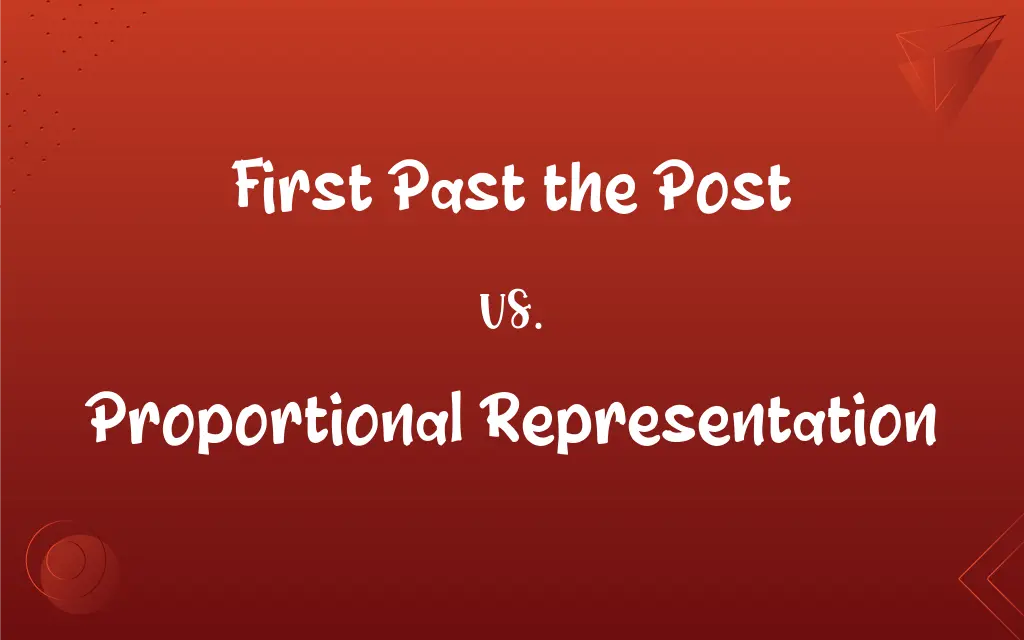First Past the Post vs. Proportional Representation: What's the Difference?
Edited by Aimie Carlson || By Janet White || Published on May 10, 2024
First Past the Post (FPTP) is a voting system where the candidate with the most votes in a constituency wins. Proportional Representation (PR) is a voting system that allocates seats based on the proportion of votes each party receives.

Key Differences
First Past the Post (FPTP) is a plurality voting method where the candidate with the highest number of votes in a single constituency is declared the winner, regardless of whether they achieve a majority. Proportional Representation (PR), conversely, allocates seats based on the overall percentage of votes a party receives, aiming to mirror the electorate's preferences more accurately.
In FPTP, smaller parties often struggle to gain representation, as the system favors larger parties and can lead to 'wasted votes' - votes not contributing to any winning candidate. PR systems, in contrast, enable smaller parties to gain representation proportionally to their vote share, reducing the occurrence of wasted votes.
FPTP is known for simplicity and producing decisive outcomes, often leading to stable majority governments. PR, however, encourages coalition governments, as it is rare for a single party to win an outright majority of the vote.
FPTP can result in disproportionate representation, where the number of seats won by a party does not reflect its share of the national vote. PR aims to address this by ensuring that the proportion of votes is closely matched by the proportion of seats.
FPTP focuses on individual candidates and their local constituencies, while PR emphasizes parties and their overall share of votes. This difference affects campaign strategies, with FPTP candidates focusing on local issues, while PR campaigns are more likely to focus on national or party-centric policies.
ADVERTISEMENT
Comparison Chart
Winner Determination
The candidate with the most votes in a constituency
Seats allocated based on party's overall vote share
Representation of Small Parties
Often marginalizes smaller parties
Enables smaller parties to gain seats proportionally
Government Formation
Tends to produce majority governments
Often leads to coalition governments
Vote Utilization
Can lead to 'wasted votes'
Reduces wasted votes, reflecting broader voter choice
Focus
Local constituency representation
Overall party representation at the national level
ADVERTISEMENT
First Past the Post and Proportional Representation Definitions
First Past the Post
Prone to marginalizing minority and smaller parties.
Small parties struggle to gain seats in FPTP unless they have strong regional support.
Proportional Representation
Encourages broader party-based national campaigns.
Campaigns in PR systems typically focus on national issues and party platforms.
First Past the Post
Elects the candidate with the most votes in a single district.
In FPTP, a candidate can win with just 40% of the vote if they have more votes than any other candidate.
Proportional Representation
Often results in coalition governments.
PR systems frequently require parties to form coalitions to govern effectively.
First Past the Post
Simple plurality system, often leading to majority rule.
FPTP typically results in a two-party system due to its winner-takes-all nature.
Proportional Representation
Allocates seats based on the percentage of votes each party receives.
In PR, if a party gets 30% of the votes, they receive roughly 30% of the seats.
First Past the Post
Can result in unrepresentative majorities.
Under FPTP, a party can control the government without winning a majority of the national vote.
Proportional Representation
Reflects a wider range of political opinions in government.
PR allows smaller, niche parties to gain representation in the legislature.
First Past the Post
Encourages a focus on key battleground constituencies.
Parties in FPTP systems often concentrate resources on swing districts.
Proportional Representation
Aims to closely match voter preference with legislative representation.
PR systems reduce the phenomenon of 'wasted votes'.
FAQs
Does PR favor larger parties?
No, it provides opportunities for smaller parties to gain seats.
What does Proportional Representation mean?
A system that allocates seats based on the proportion of votes each party gets.
How does FPTP affect smaller parties?
It often disadvantages them, as winning requires a plurality in each district.
What type of governments does FPTP usually produce?
Often majority governments with one dominant party.
Are coalition governments common in PR systems?
Yes, since no single party typically wins an outright majority.
What are 'wasted votes' in FPTP?
Votes for losing candidates or excess votes for winning candidates.
What is First Past the Post?
A voting system where the candidate with the most votes in a district wins.
Can a party win a majority in PR systems?
It's rare, as the vote is usually spread among more parties.
Is PR more complex than FPTP?
It can be, due to the calculations needed for seat allocation.
Does FPTP encourage tactical voting?
Yes, voters often choose the lesser of two evils to avoid wasting votes.
Can FPTP lead to disproportionate representation?
Yes, parties can win more seats than their national vote share would suggest.
Do FPTP systems encourage political diversity?
Less so, as they tend to favor established, larger parties.
How does PR affect voter engagement?
It can increase engagement by making every vote count towards representation.
Is PR more representative of voter choice?
Yes, it aims to reflect the overall preferences of the electorate.
Can FPTP lead to a two-party system?
Yes, due to its winner-takes-all nature.
Can independent candidates succeed in FPTP?
It's challenging, but possible in districts where they have strong support.
Is vote counting simpler in FPTP?
Yes, as it's just a matter of counting votes per candidate.
How does campaign strategy differ between FPTP and PR?
FPTP focuses on winning individual districts, while PR focuses on national party strategies.
Does PR require a minimum vote threshold?
Some PR systems have thresholds to prevent fragmentation.
Is PR fairer than FPTP?
Many argue it is, as it more accurately reflects the electorate's will.
About Author
Written by
Janet WhiteJanet White has been an esteemed writer and blogger for Difference Wiki. Holding a Master's degree in Science and Medical Journalism from the prestigious Boston University, she has consistently demonstrated her expertise and passion for her field. When she's not immersed in her work, Janet relishes her time exercising, delving into a good book, and cherishing moments with friends and family.
Edited by
Aimie CarlsonAimie Carlson, holding a master's degree in English literature, is a fervent English language enthusiast. She lends her writing talents to Difference Wiki, a prominent website that specializes in comparisons, offering readers insightful analyses that both captivate and inform.






































































